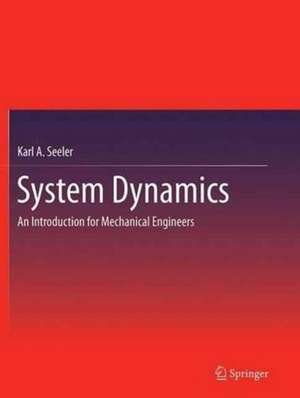System Dynamics: An Introduction for Mechanical Engineers
Autor Karl A. Seeleren Limba Engleză Paperback – 24 sep 2016
Preț: 518.85 lei
Preț vechi: 640.55 lei
-19% Nou
Puncte Express: 778
Preț estimativ în valută:
99.30€ • 103.28$ • 81.97£
99.30€ • 103.28$ • 81.97£
Carte tipărită la comandă
Livrare economică 11-17 aprilie
Preluare comenzi: 021 569.72.76
Specificații
ISBN-13: 9781493954629
ISBN-10: 1493954628
Pagini: 683
Ilustrații: XVI, 667 p. 1437 illus., 1008 illus. in color.
Dimensiuni: 210 x 279 mm
Ediția:Softcover reprint of the original 1st ed. 2014
Editura: Springer
Colecția Springer
Locul publicării:New York, NY, United States
ISBN-10: 1493954628
Pagini: 683
Ilustrații: XVI, 667 p. 1437 illus., 1008 illus. in color.
Dimensiuni: 210 x 279 mm
Ediția:Softcover reprint of the original 1st ed. 2014
Editura: Springer
Colecția Springer
Locul publicării:New York, NY, United States
Cuprins
Introduction.- Differential Equations, Input Functions, Complex Exponentials, and Transfer Functions.- Introduction to the Linear Graph Method, Step Responses, and Superposition.- Mechanical Systems.- Fluid, Electrical, and Thermal Systems.- Power Transmission, Transformation and Conversion.- Vector-Matrix Algebra and the State-Space Representation of Dynamic Systems.- Finite Difference Methods and MATLAB.- Transfer Functions, Block Diagrams and the s-plane.- Frequency Response.- AC Circuits and Motors.
Notă biografică
Professor Karl Seeler is Professor of Mechanical Engineering at Lafayette College. His research interests mechanical properties of polymer, microcellular polymers, structural stability, machine safety, and systems dynamics. He holds a PhD from MIT.
Textul de pe ultima copertă
This essential textbook takes the student from the initial steps in modeling a dynamic system through development of the mathematical models needed for feedback control. The generously-illustrated, student-friendly text focuses on fundamental theoretical development rather than the application of commercial software. Practical details of machine design are included to motivate the non-mathematically inclined student.
This book also:
Emphasizes the linear graph method for modeling dynamic systems
Offers a systematic approach for creating an engineering model, extracting information, and formulating mathematical analyses
Adopts a unifying theme of power flow as the dynamic agent that eases analysis of hybrid systems, such as machinery
Presents differential equations as dynamic operators and stresses input/output relationships
Introduces Mathcad and programming in MATLAB
Allows for use of Open Source Computational Software (R or C)
Features over 1000 illustrations
This book also:
Emphasizes the linear graph method for modeling dynamic systems
Offers a systematic approach for creating an engineering model, extracting information, and formulating mathematical analyses
Adopts a unifying theme of power flow as the dynamic agent that eases analysis of hybrid systems, such as machinery
Presents differential equations as dynamic operators and stresses input/output relationships
Introduces Mathcad and programming in MATLAB
Allows for use of Open Source Computational Software (R or C)
Features over 1000 illustrations
Caracteristici
Emphasizes the linear graph method for modeling dynamic systems Offers a systematic approach for creating an engineering model, extracting information, and formulating mathematical analyses Adopts a unifying theme of power flow as the dynamic agent that eases analysis of hybrid systems, such as machinery Presents differential equations as dynamic operators and stresses input/output relationships Introduces Mathcad and programming in MATLAB Allows for use of Open Source Computational Software (R or C) Features over 1300 illustrations
